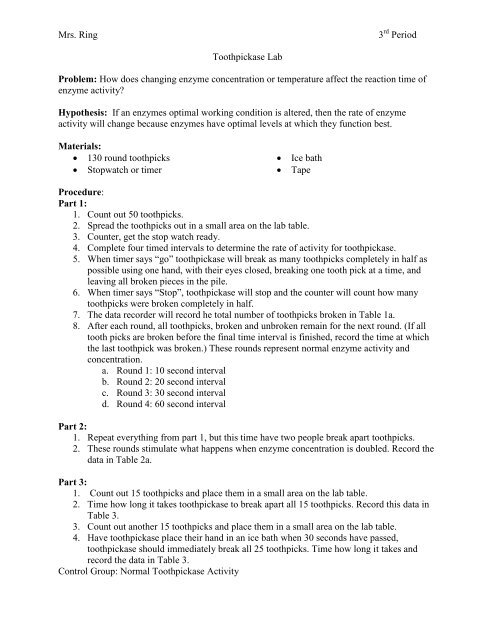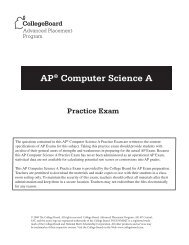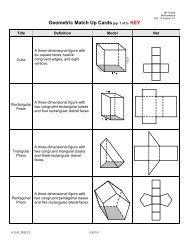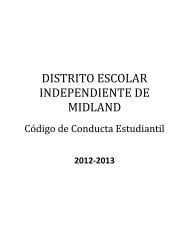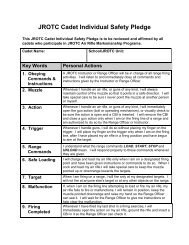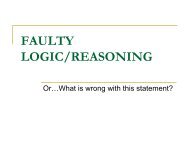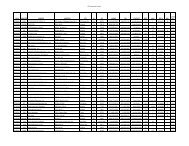Toothpickase Lab Report
Toothpickase Lab Report
Toothpickase Lab Report
Create successful ePaper yourself
Turn your PDF publications into a flip-book with our unique Google optimized e-Paper software.
Mrs. Ring3 rd Period<strong>Toothpickase</strong> <strong>Lab</strong>Problem: How does changing enzyme concentration or temperature affect the reaction time ofenzyme activity?Hypothesis: If an enzymes optimal working condition is altered, then the rate of enzymeactivity will change because enzymes have optimal levels at which they function best.Materials: 130 round toothpicks Stopwatch or timerIce bathTapeProcedure:Part 1:1. Count out 50 toothpicks.2. Spread the toothpicks out in a small area on the lab table.3. Counter, get the stop watch ready.4. Complete four timed intervals to determine the rate of activity for toothpickase.5. When timer says “go” toothpickase will break as many toothpicks completely in half aspossible using one hand, with their eyes closed, breaking one tooth pick at a time, andleaving all broken pieces in the pile.6. When timer says “Stop”, toothpickase will stop and the counter will count how manytoothpicks were broken completely in half.7. The data recorder will record he total number of toothpicks broken in Table 1a.8. After each round, all toothpicks, broken and unbroken remain for the next round. (If alltooth picks are broken before the final time interval is finished, record the time at whichthe last toothpick was broken.) These rounds represent normal enzyme activity andconcentration.a. Round 1: 10 second intervalb. Round 2: 20 second intervalc. Round 3: 30 second intervald. Round 4: 60 second intervalPart 2:1. Repeat everything from part 1, but this time have two people break apart toothpicks.2. These rounds stimulate what happens when enzyme concentration is doubled. Record thedata in Table 2a.Part 3:1. Count out 15 toothpicks and place them in a small area on the lab table.2. Time how long it takes toothpickase to break apart all 15 toothpicks. Record this data inTable 3.3. Count out another 15 toothpicks and place them in a small area on the lab table.4. Have toothpickase place their hand in an ice bath when 30 seconds have passed,toothpickase should immediately break all 25 toothpicks. Time how long it takes andrecord the data in Table 3.Control Group: Normal <strong>Toothpickase</strong> Activity
Mrs. Ring3 rd PeriodTable 1a:<strong>Toothpickase</strong> ActivityInterval Time (sec.) Cumulative time (sec) Total # toothpicks broken10 10 320 30 930 60 2160 120 37Table 1b:Rate of <strong>Toothpickase</strong> ActivityTime interval (sec.)Rate of activity (# of toothpicks broken/sec)0-10 .310-30 .4530-60 .760-120 .616Table 2a:Rate of <strong>Toothpickase</strong> Activity – Doubled Enzyme ConcentrationTime interval (sec.) Cumulative time (sec) Total # toothpicks broken10 10 420 30 1230 60 2460 120 47Table 2b:Rate of <strong>Toothpickase</strong> Activity – Doubled Enzyme ConcentrationTime interval (sec.)Rate of activity (# of toothpicks broken/sec)0-10 .410-30 .630-60 .860-120 .78Table3:Rate of <strong>Toothpickase</strong> Activity - TemperatureConditions Toothpick # Time (sec)Normal Temperature 15 :85Reduced temperature 15 :143
Amount of Time (seconds)Number of Toothpicks BrokenMrs. Ring3 rd PeriodToothpicks Broken by <strong>Toothpickase</strong> at Normal and Doubled Concentrations5045403530252015Normal <strong>Toothpickase</strong>Doubled Concentration105010 20 30 60Time (seconds)Toothpicks Broken by <strong>Toothpickase</strong> at Normal and Lowered Temperature180160140120100806040200Normal TemperatureTemperatureLowered Temperature
Mrs. Ring3 rd PeriodQualitative Data:In Part 1 of the experiment, toothpickase was working alone to represent a normal concentration.At normal concentration toothpickase broke a total of thirty seven toothpicks in 120 seconds. InPart 2 of the experiment toothpickase we used two people showing that concentration wasdoubled. <strong>Toothpickase</strong> was then able to break forty seven toothpicks in 120 seconds. Rate ofenzyme activity between Part 1 and Part 2 was increased by twenty percent. In Part 3 of ourexperiment we measured how long it would take toothpickase to break apart fifteen toothpicks atnormal (room) temperature. It took toothpickase one minute and twenty five seconds to breakall fifteen. After that, toothpickase’s temperature was lowered by soaking it in an ice bath forthirty seconds. When the temperature was lowered it took toothpickase two minutes and twentythree seconds to break fifteen toothpicks. Again, when we changed the optimal level offunctioning, the rate of activity was affected.Analysis/Conclusion:Our hypothesis was supported because changing the concentration had a mild effect onthe enzyme activity rate and changing the temperature dramatically changed the rate of enzymereactivity. <strong>Toothpickase</strong> at a normal concentration was able to break thirty seven toothpicks.When the concentration was doubled there was a twenty percent increase in enzyme activity. Atroom temperature, toothpickase was able to break a total of fifteen toothpicks down in oneminute and twenty five seconds. When toothpickase’s temperature was lowered it took roughlyone minute longer to break down the same number of toothpicks.During the lab it was possible that some errors occurred. Since there was no set area forthe toothpicks to placed, it is possible that between experiments we spread the toothpicks outover differing amounts of space. If we were to repeat this experiment we could place thetoothpicks in a box or draw out a set area on the lab table in which the toothpicks could beplaced.


